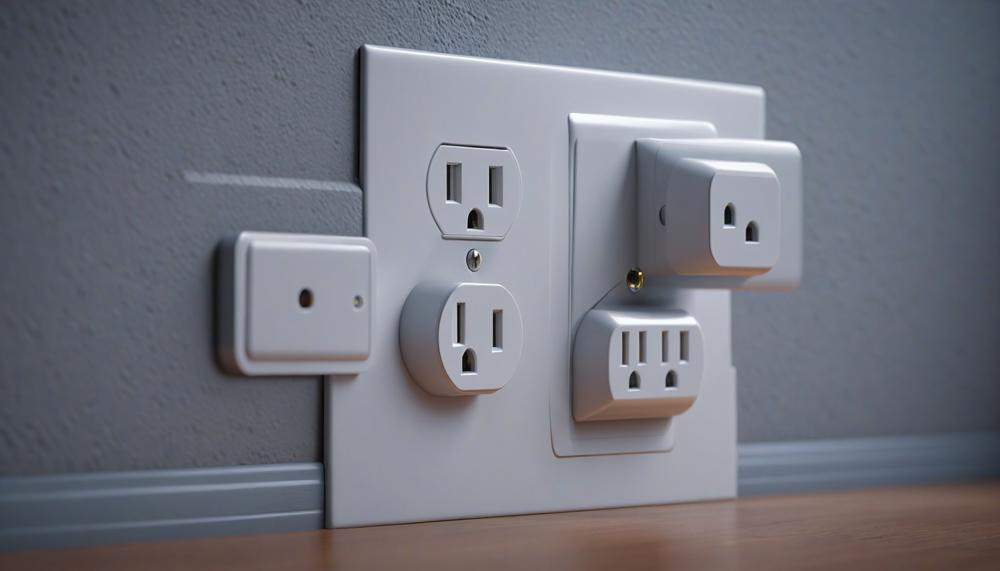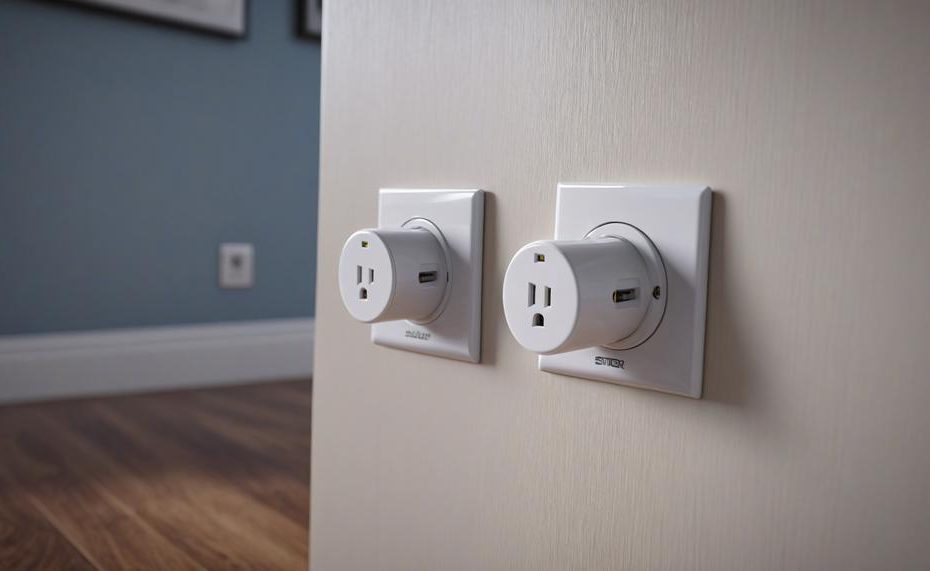Getting frustrated with tamper-resistant outlets? You’re not alone. These outlets, while essential for safety, can be a real challenge when you’re trying to plug in a device. But don’t worry, there’s a method to overcome this hurdle.
Here’s a quick guide on how to bypass tamper-resistant outlets and make your life a little easier:
Key Takeaways:
- Understand the Mechanism: Tamper-resistant outlets are designed with safety shutters that prevent foreign objects from being inserted. These shutters only open when equal pressure is applied to both slots.
- Proper Plugging Technique: Insert the plug with a downward angle, applying pressure while moving it up and down to align the prongs with the shutters.
- Loosening the Outlet: Repeatedly insert and remove the plug to wear down the resistance, making future insertions easier.
- Manual Removal: If all else fails, you can remove the outlet by taking off the plate and unscrewing the tamper-resistant screws.
How to Bypass Tamper-Resistant Outlets:
- Angle the Plug Downwards: Start by inserting the plug prongs into the outlet at a slight downward angle.
- Apply Pressure and Push Down: Press firmly and push down while moving the plug in and out.
- Increase Speed: Speed up the motion to help align the prongs with the shutters inside the outlet.
- Repeat as Needed: Continue this process until the prongs bypass the tamper-resistant mechanism.
Tamper-resistant outlets are a great safety feature, but knowing how to work with them efficiently can save you a lot of hassle. Remember to handle electrical outlets with care to avoid any safety risks.
Contents
- 1 What Exactly are Tamper-Resistant (TR) Receptacles?
- 2 How to Tell If an Outlet is Childproof?
- 3 Method 1: Look for TR on the Receptacle
- 4 Method 2: Look for the Outlet Slot Covers
- 5 Method 3: Plug Something Into the Outlet
- 6 Where Should You Use Tamper Proof Outlets?
- 7 How to Use a Tamper-Resistant Receptacle
- 8 Conclusion
What Exactly are Tamper-Resistant (TR) Receptacles?
Tamper-resistant (TR) receptacles are designed to enhance safety compared to standard outlets. The primary difference lies in the internal mechanism that TR receptacles employ to prevent accidental insertion of foreign objects. Here’s a detailed breakdown:
| Feature | Standard Outlets | Tamper-Resistant (TR) Receptacles |
| Internal Safety Shutters | No internal safety shutters. | Equipped with internal safety shutters that block the slots unless both prongs of a plug are inserted simultaneously. |
| Child Safety | Children can easily insert objects into the slots, posing a risk of electrical shock. | The safety shutters prevent insertion of foreign objects, significantly reducing the risk of electrical shock to children. |
| Identification | Standard outlets do not have specific markings. | TR receptacles are often marked with a capital “TR” embossed on the face of the outlet. |
| Regulation | Not required by the National Electric Code (NEC). | Required by the NEC for all new and renovated installations in residential settings. |
| Ease of Use | Easy to plug in without resistance. | May require slight additional pressure to insert a plug, due to the safety mechanism. |
Prevention of Electrical Hazards
- Safety Shutters: The built-in safety shutters inside TR receptacles act as barriers, closing off access to the hot and neutral slots unless both prongs of a plug are inserted simultaneously. This mechanism prevents children from inserting items like hairpins, keys, or paper clips into one of the slots, thereby avoiding potential electric shocks.
- Compliance with Safety Standards: As mandated by the NEC, the installation of TR receptacles in new and renovated homes ensures a higher standard of safety. These outlets are specifically designed to protect curious young ones in environments where they are likely to explore electrical outlets.
- Visual and Functional Similarity: TR receptacles maintain the same appearance and functionality as standard outlets, which means they do not disrupt the aesthetic or usability of a space. This makes them an easy upgrade for enhancing safety without compromising on design.
How to Tell If an Outlet is Childproof?
Determining whether an outlet is childproof involves checking for several key features that indicate safety measures are in place. Here are the main signs to look for:
- Tamper-Resistant (TR) Outlets: These are designed with a built-in shutter mechanism that blocks foreign objects from being inserted. Look for “TR” markings on the outlet. When you try to insert a plug, you should feel resistance unless the plug is inserted evenly in both slots.
- Outlet Covers and Plugs: These are physical barriers placed over the outlet openings to prevent access. Check if the outlets have plastic covers that need to be removed or plugs that fill the socket holes.
- Shuttered Outlets: Some outlets have internal shutters that prevent anything but a proper plug from going in. Test by inserting a plug; if it doesn’t go in easily, the shutters are likely engaged.
- Labels and Markings: Look for outlets with labels indicating tamper resistance. They might be marked with “child-safe” or similar terminology.
- State Building Codes Compliance: Verify if your state requires tamper-resistant outlets in homes, particularly in newer constructions. This can be a good indicator that the outlets are childproof.
Method 1: Look for TR on the Receptacle
Identifying a tamper-resistant (TR) receptacle is straightforward if you know what to look for. The primary visual indicator is the “TR” marking on the receptacle itself. Here are the key visual cues:
- Embossed TR Marking: The most prominent feature is the capital “TR” embossed or stamped on the face of the receptacle. This marking is usually found near the outlet slots, indicating that the receptacle meets the National Electrical Code (NEC) requirements for tamper resistance.
- Shutter Mechanism: Look closely at the outlet slots. TR receptacles have a built-in shutter mechanism that prevents the insertion of foreign objects. These shutters remain closed unless equal pressure is applied to both slots simultaneously, allowing plugs to be inserted.
- Brand and Model Indications: Some manufacturers may include additional labels or stickers on the receptacle indicating its tamper-resistant feature. This information can often be found on the packaging or in the product specifications.
- Colour Coding: While not a universal indicator, some manufacturers use specific colours or design elements to denote tamper-resistant features. Checking the manufacturer’s guidelines can provide more details.
Method 2: Look for the Outlet Slot Covers
Identifying whether an outlet is tamper resistant (TR) involves inspecting the slot covers. Here are several methods to determine if an outlet has these safety features:
Check for “TR” Marking
Look for the letters “TR” embossed on the faceplate of the outlet, usually positioned between the two vertical slots.
This marking indicates the outlet is designed to prevent tampering.
Observe the Slot Covers
Tamper-resistant outlets feature internal plastic shutters. These shutters only open when equal pressure is applied to both slots, such as when inserting a plug. You can identify them by:
- Flashlight Inspection: Shine a flashlight into the slots to see if there’s a plastic shutter behind them. In tamper-resistant outlets, you’ll notice a lighter, opaque cover rather than a dark hole.
Slot Appearance
Regular outlets will appear as open, dark holes, while tamper-resistant ones will show a barrier or plate covering the slots. This plate is part of the mechanism that prevents foreign objects from being inserted.

Outlet Style
Modern tamper-resistant outlets might have a different design or visual appearance compared to older models. They often have a more robust or reinforced look due to the internal shutter mechanism.
Installation Date
Consider the building’s age. If your home was built or had electrical work done after 2008, it is likely to have tamper-resistant outlets, as the National Electrical Code mandated their installation from that year onward.
Brand and Model
Some brands explicitly label their outlets with tamper-resistant features on the packaging or the outlet itself. This can be cross-referenced by checking the model online or in product manuals.
Documentation and Labelling
Refer to any electrical work documentation or labelling within your home’s breaker box. It might indicate whether TR outlets were installed.
Method 3: Plug Something Into the Outlet
To safely and effectively disable tamper-resistant (TR) outlets in your home, follow these steps:
| Step | Action | Details |
| 1 | Angle the Plug | Angle the plug downward while inserting it into the outlet. |
| 2 | Apply Pressure | Firmly press the plug into the outlet to engage the mechanism. |
| 3 | Move the Plug | Move the plug up and down to align with the internal shutters. |
| 4 | Speed Up | Increase the speed of pushing the plug in and out to wear down the mechanism. |
| 5 | Repeat | Repeat the process multiple times to permanently loosen the tamper-resistant feature. |
Tamper-resistant outlets are designed to protect children from electrical shocks, so disabling them should be considered carefully. If you decide to disable them for convenience, ensure to supervise young children closely or consider using alternative safety measures.
Where Should You Use Tamper Proof Outlets?
Tamper proof outlets, also known as tamper-resistant receptacles (TRRs), should be used in areas of the home where children are likely to explore and where electrical hazards are most prevalent. These areas include:
- Living Rooms and Bedrooms: Children spend a lot of time playing in these rooms. Installing tamper proof outlets ensures their curiosity doesn’t lead to dangerous electrical incidents.
- Kitchens and Bathrooms: These areas are particularly risky due to the presence of water, which can conduct electricity. Tamper proof outlets reduce the risk of electrical shocks in these high-risk zones.
- Playrooms and Nurseries: These are spaces specifically designed for children, making them prime areas for tamper proof outlets to protect against potential electrical hazards.
- Hallways and Staircases: Often overlooked, these areas are common pathways where children might be tempted to explore outlets.
- Home Offices and Garages: With various appliances and tools, these areas can pose a significant risk. Tamper proof outlets help prevent accidental insertions.
- Outdoor Areas: Any outdoor outlet should be tamper resistant, especially if within reach of children. These outlets are also often exposed to weather elements, making the protection even more critical.
The National Electrical Code (NEC) has mandated since 2008 that all new and renovated homes must install tamper proof outlets throughout the entire home. This requirement underscores the importance of these outlets in preventing electrical injuries.
How to Use a Tamper-Resistant Receptacle
When using a tamper-resistant receptacle (TRR), it is important to follow specific steps to ensure safety and prevent tampering.
Proper Installation
Ensure the TRR is installed correctly by a qualified electrician to guarantee it meets all safety standards and building codes.
Inspect Plugs Before Use
Avoid using plugs with cracks, breaks, or bent prongs. Always inspect your plugs before inserting them into the TRR.
Dry Environment
Keep the TRR and surrounding area dry. Water exposure can be hazardous and may cause electrical faults.
Proper Plug Insertion
Angle the plug downward, applying pressure while moving it up and down until it fits snugly. This may take several attempts to align the prongs properly.
Routine Checks
Regularly check your TRR for any signs of wear or damage. Replace any compromised receptacles immediately.
Child and Pet Safety
If you have small children or pets, replace all non-TRRs in your home with tamper-resistant outlets to enhance safety.
Conclusion
Tamper-resistant outlets, while essential for child safety, can be frustrating to use. Understanding the mechanism behind these outlets is the first step in overcoming this challenge. They feature internal shutters that only open when equal pressure is applied to both slots, preventing the insertion of foreign objects.
To bypass tamper-resistant outlets, follow these steps:
- Angle the Plug Downwards: Start by inserting the plug prongs at a slight downward angle.
- Apply Pressure and Push Down: Firmly press and push down while moving the plug in and out.
- Increase Speed: Speed up the motion to help align the prongs with the shutters inside the outlet.
- Repeat as Needed: Continue this process until the prongs bypass the tamper-resistant mechanism.
If these steps prove ineffective, you can manually remove the outlet by taking off the plate and unscrewing the tamper-resistant screws. This repeated practice will wear down the resistance, making future insertions easier.
Tamper-resistant outlets are a great safety feature, but with these techniques, you can use them more smoothly while maintaining the safety they provide.





